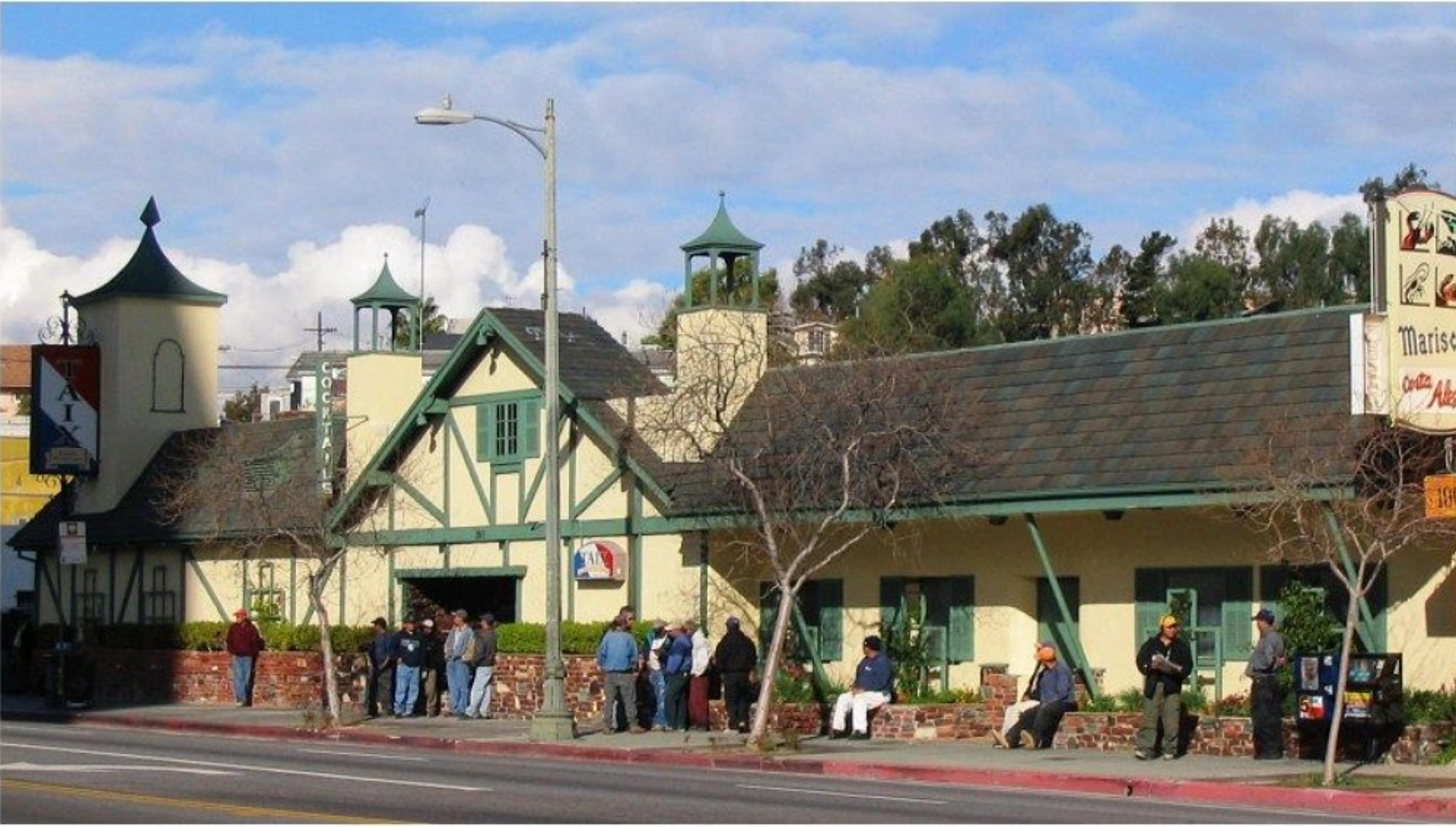More than just a shadow encroaching; that’s doom. Pinterest
Taix Restaurant, at 1911 West Sunset, has not had her demo permit pulled.
Yet. But it will happen. As recently reported, Taix is not long for this world.
Curbed readers, being Curbed readers, reacted as Curbed readers generally do.
Curbed LA
Other people, however, reacted differently.
Full disclosure: I dig Taix the most. In fact, when installed as president of Burbank Shrine Club, I angled to have my installation held at Taix rather than in Burbank, because why wouldn’t I?
Dude, seriously, anyone who isn’t instantly charmed by its Norman-Tudor village vernacular has a dead soul. The most common negative epithet hurled by the Curbed Class is “well if preservationists like it so much why don’t they give it business?!” (a whole twelve disingenuous points below “well if you love it so much why don’t you buy it?”) and the answer is we do give it business, you sad, sad, little men.
LocalFoodEater
Look at the fanciful way they merge interior/external space. This image taken from an excellent write-up of Taix in Ellen Bloom’s wonderful blog
Fun fact: see the second-story window in the gable? There’s no actual room up there—it’s not a real window. Yes! Just like Disneyland!
Image courtesy LATimes
Taix, of course, is a Los Angeles institution, and you can read about its history—and see images of its original home at 321 Commercial—here.
Folks get confounded when they try and figure out where the old Taix structure used to be; rightfully so. Commercial Street ran NW from Alameda; I’ve marked the approximate site of Taix where it stood from 1927-1962.
Less has been said of its post-relocation building. 1911 West Sunset began as a restaurant built for Mrs. Ona Spaulding, designed by architect Edgar E. Butler, and built in 1929; it is run by restaurateur Noah Botwin and is famously known as a hangout for the politicos and police bosses. Spaulding hires architect C. F. Plummer to add a cocktail lounge in the summer of 1938, and hires architect Henry Dean to give it an addition in 1947. It remains Botwins for over thirty years before becoming Rafael’s for all of one year, in 1961, before Mr. Taix’s purchase in 1962. There’s a permit in June of that year to stucco and wood trim the front, thus giving the place its French Provincial character. The west half of Taix to the left of the center gable, with the tall tower, is added in the summer of 1968, and is by Nielsen, Moffat & Wolverton.
Its original incarnation looked, presumably, like this:
From the Flickr feed of jericl
…magnificently illuminated by City Hall. One wonders if it did indeed have such impressive rooftop signage.
Here it is after its 1938 expansion to the east:
And how it appeared after the 1947 expansion to the west, doubling its size.
And its Late Moderne-meets-Klondike bones lurk beneath to this day:
Something else: when Taix moved in and put a gable and half timbering where it once said “Sierra Room,” he elected to retain and maintain the 1940s neon sign:
And so, you might want to spend some time at Taix before she goes away. _Yes_, I am aware that there will be a mini-Taix reconstructed within the new six-story, 170-unit development.
1111 Wilshire, a typical Holland Residential development, of similar size to that proposed for the Taix site. So now you know what to expect.
About Nathan Marsak
NATHAN MARSAK says: “I came to praise Los Angeles, not to bury her. And yet developers, City Hall and social reformers work in concert to effect wholesale demolition, removing the human scale of my town, tossing its charm into a landfill. The least I can do is memorialize in real time those places worth noting, as they slide inexorably into memory. In college I studied under Banham. I learned to love Los Angeles via Reyner’s teachings (and came to abjure Mike Davis and his lurid, fanciful, laughably-researched assertions). In grad school I focused on visionary urbanism and technological utopianism—so while some may find the premise of preserving communities so much ill-considered reactionary twaddle, at least I have a background in the other side. Anyway, I moved to Los Angeles, and began to document. I drove about shooting neon signs. I put endless miles across the Plains of Id on the old Packard as part of the 1947project; when Kim Cooper blogged about some bad lunch meat in Compton, I drove down to there to check on the scene of the crime (never via freeway—you can’t really learn Los Angeles unless you study her from the surface streets). But in short order one landmark after another disappeared. Few demolitions are as contentious or high profile as the Ambassador or Parker Center; rather, it is all the little houses and commercial buildings the social engineers are desperate to destroy in the name of the Greater Good. The fabric of our city is woven together by communities and neighborhoods who no longer have a say in their zoning or planning so it’s important to shine a light on these vanishing treasures, now, before the remarkable character of our city is wiped away like a stain from a countertop. (But Nathan, you say, it’s just this one house—no, it isn’t. Principiis obsta, finem respice.) And who knows, one might even be saved. Excelsior!””
Nathan’s blogs are: Bunker Hill Los Angeles, RIP Los Angeles & On Bunker Hill.
